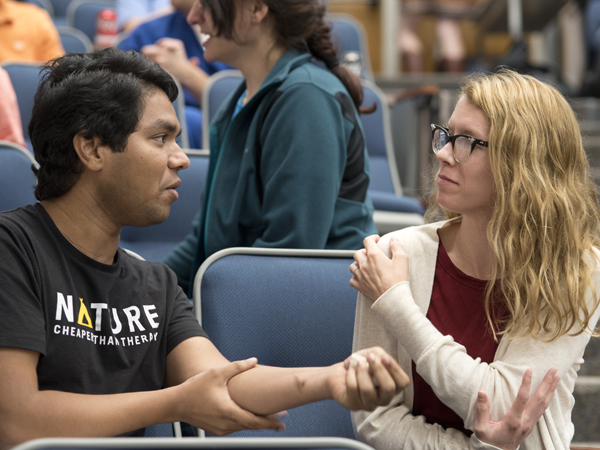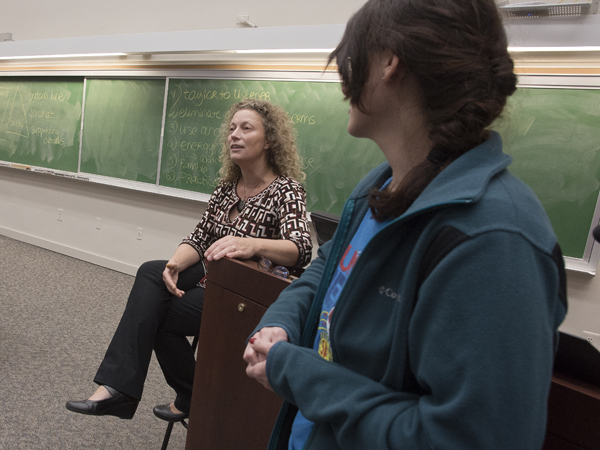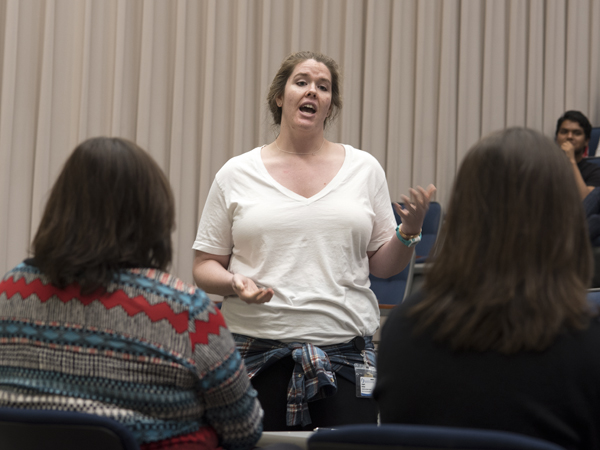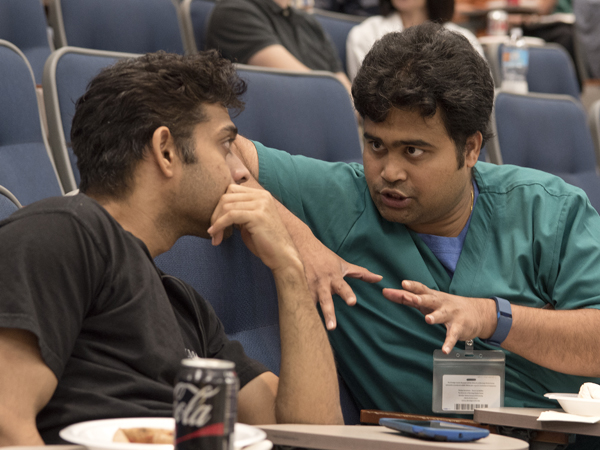Practice makes pitch perfect

You're a time traveler, transported back to the year 1760. You take your cell phone out of your pocket, expecting a call from the future. Then a passer-by asks, “What's that?”
How do you explain to your new friend what a cell phone is and how it works?
No, it's not a “Back to the Future” sequel. It was a communication exercise during the School of Graduate Studies in the Health Sciences career opportunities and professional development seminar series in October.
The seminars teach graduate students and postdoctoral fellows about career paths and the relevant skill sets. This month's topic was crafting an elevator pitch.
“The elevator pitch is a concise overview of an idea, project or solution,” said Dr. Lique Coolen, associate dean of postdoctoral studies in the graduate school.
While the origin of the term elevator pitch isn't clear or simple, the act itself should be. It's usually prompted by that ubiquitous question, “So, what do you do for a living?” The pitch is your answer.
“The purpose is to get people interested in a topic and encourage them to continue this discussion with you,” said Coolen, who coordinates the seminar series. “That discussion could be a simple exchange of business cards or a coffee break at Starbucks.”

In business, the elevator pitch is a sales tactic for a product or service. For young scientists, the products are themselves and their research. It can help them find a job, secure grant funding or build their professional network.
So what do silly-sounding time-travel scenarios have to do with career development? These exercises help students hone science communication techniques they can then use for their pitches.
Coolen's first tip for the students was to tailor the pitch to the listener. Are you speaking with a fellow scientist at a conference or a stranger at a baseball game? For the exercises, Coolen asked the students to assume “you're speaking to an intelligent person, someone with a college degree.
“However, that degree may not be in science,” she added.
Because people may have limited knowledge of your research topic, tip number two is to avoid jargon. Those are the words and phrases only a specialist would know. Or in the time-traveler's case, words and phrases, such as "telephone," "Morse code" and "electricity."
Students said they found the exercise fun, yet challenging.
“You take for granted your knowledge of electronics and how they work,” said Elena Dent, a Ph.D. student in physiology and biophysics. “Prior to this workshop, I had not viewed those encounters where someone asks me what I do as an opportunity to practice my pitch.”
Here's another scenario the students tried: Your friend from 1760 has a broken arm. Explain to him or her why he or she should get an X-ray.
Ramana Vaka, a Ph.D. student in medical pharmacology, played time-traveler while Dent played the injured friend.
“[An X-ray] makes an image, like a portrait,” Vaka said.
“Is it going in inside my arm?” Dent asked.
“No.”
“Is it going to fix my arm?”
“No.”
“Then why do I need an X-ray?”
“Because we can't see where your bone is broken. We need to see inside your arm to know how to fix it.”

Additional students compared X-rays to portraits and paintings. That illustrates another important elevator pitch tip: use appropriate analogies.
Others took a less successful approach.
“Whose partner failed to explain X-rays well?” Coolen asked.
“My partner said I was going to have stuff blasted through my arm,” one student said. “I asked him if that was going to hurt.”
The National Institutes of Health says communication skills are one of the core competencies Ph.D.-trained scientists must develop to be competitive in the workforce. The graduate school at UMMC is committed to helping students develop their professional toolkit, Coolen said.
“It is important that we provide training that gives students competencies needed for multiple career options,” Coolen said.
At the end of the seminar, the trainees packed away the time machines and practiced their real-time pitches.
Dr. Krishna Vallabhaneni, instructor in radiation oncology, described his research on the tumor microenvironment. Using an analogy, he said tumors grow like a plant: If they get the resources they need, they can flourish. However, he broke the jargon rule when “extracellular vesicles” entered the pitch.

Coolen said she learned the exercises at workshops hosted by the American Association of Medical Colleges and the Alan Alda Center for Communicating Science. Based at Stony Brook University in New York, the Alda Center trains scientists to discuss their work and its relevance with the public.
After all, it's not just funding agencies and potential employers that might be interested in your research. Thanksgiving is coming, Coolen said, and your grandmother will want to learn about what you do.
Coolen will organize additional interactive workshops later this year for the trainees. Before then, they should be practicing their pitches.
“You should be able to explain why your research is different and what sets it apart,” Coolen said.


